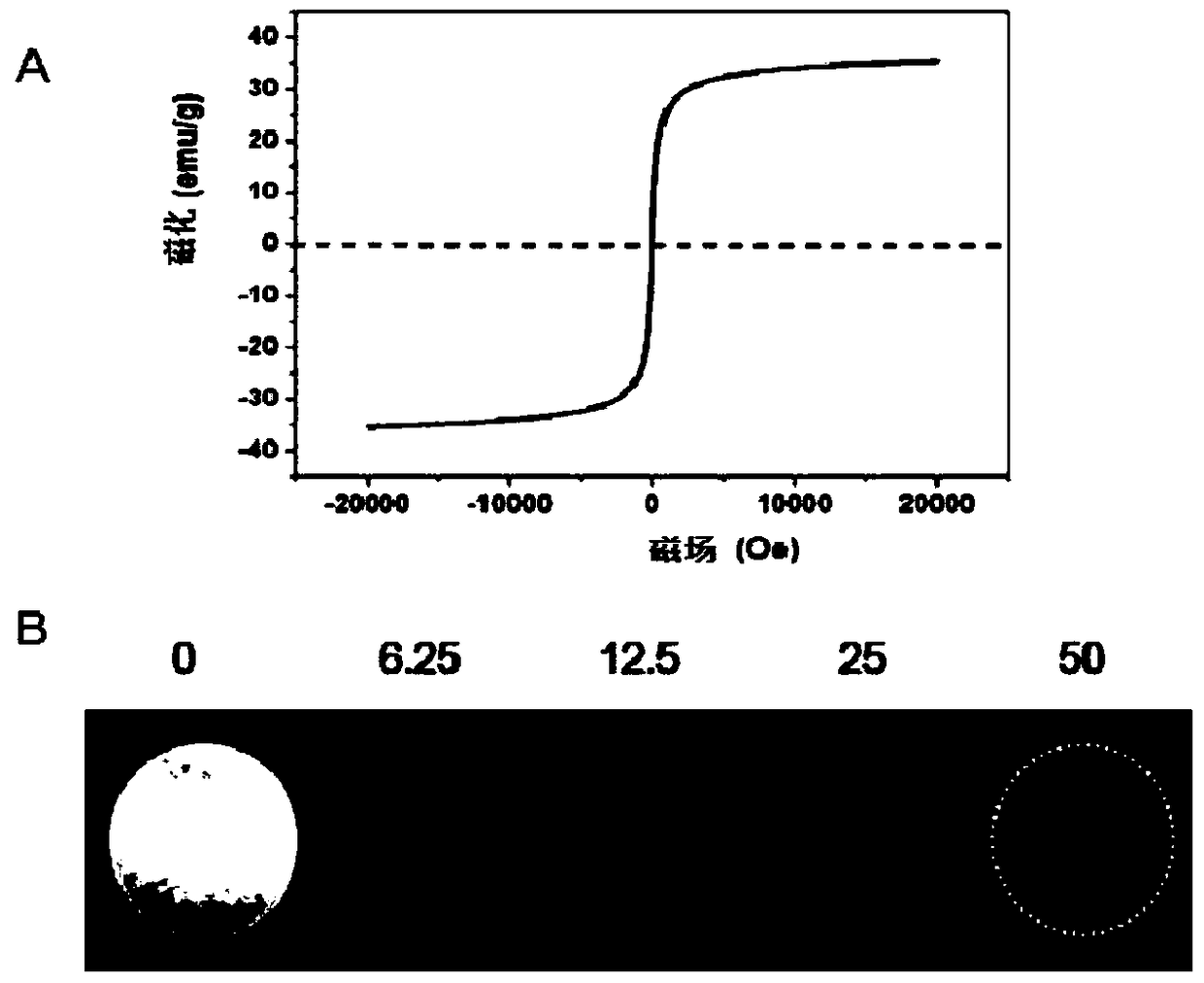Targeted nano magnetic resonance contrast agent for brain epileptic focus and its preparation and application
A magnetic resonance contrast agent and epilepsy technology, which is applied in the field of molecular imaging to achieve the effect of evaluating prognosis, improving accuracy and safety, and evaluating curative effect
- Summary
- Abstract
- Description
- Claims
- Application Information
AI Technical Summary
Problems solved by technology
Method used
Image
Examples
Embodiment 1
[0048] This embodiment provides a targeted nano-magnetic resonance contrast agent for cerebral epileptic focus and its preparation, as follows:
[0049] Preparation of PEG-USPIO nanoparticles: Accurately weigh 10 mg lipid USPIO, 50 mg DSPE-PEG-MAL, 5 mg DSPE-PEG-FITC, dissolve in 2 ml of dichloromethane, sonicate for 10 min in an ice-water bath, and spin steam at 37°C for 15 min to remove Chloromethane, centrifuged at 2500rpm at 4°C for 10min, discarded the supernatant, dispersed and precipitated with 0.5mL deionized water to obtain nanoparticles.
[0050] Preparation of pepstatin A-PEG-USPIO nanoparticles: add sulfhydryl activating reagent pepstatin A 2mg / ml0.5ml to the prepared deionized water-dispersed nanoparticles 2ml (5mg / mL USPIO) and stir for 4h at low speed , centrifuged at 2500rpm at 4°C for 10min, discarded the supernatant, dispersed and precipitated with 0.5mL 0.01M PBS (pH7.4) to obtain the nanoparticles with targeting functional molecules we needed.
[0051] Use...
Embodiment 2
[0053] BCEC cells (rat brain capillary endothelial cells) were 5×10 5 The concentration of cells in each well was seeded in a six-well plate for experiments; 1-3 wells were the blank control group; 4-6 wells were the experimental group, and 100uM (1.5g / 100ml) glutamic acid was added to each well, and incubated at 37°C for 30min Afterwards, PBS (phosphate buffered saline) was washed twice, and complete culture medium was added for routine culture; 24 hours later, each group was added with PBS, PEG-USPIO, pepstatin A-PEG-USPIO (USPIO concentration was 50 μg / ml), and After 30 minutes, samples were taken for immunofluorescence confocal qualitative analysis and flow cytometry FITC fluorescence quantitative analysis. The results were as follows: Figure 4 , Figure 5 Shown: Figure 4 The indicated glutamate can induce high P-glycoprotein in BCEC cells, Figure 5 The indicated targeting function molecule pepstatin A can occupy the binding site of P-glycoprotein, which is helpful f...
Embodiment 3
[0055] Stereotaxic SD rat left hippocampus CA3 area, microneedle injection of 3 μL kainic acid (KA, 0.5 mg / mL) to establish animal models of epilepsy; injection of 3 μL PBS (phosphate buffer) as the sham operation control group; more than 4% The heart was perfused with polyformaldehyde, and the brain was removed. The expression of P-glycoprotein in the hippocampus of the epilepsy group and the sham operation group was observed by immunofluorescence confocal imaging and Western Blot analysis. The results are as follows: Image 6 Shown: Image 6 It showed that the expression of P-glycoprotein in the hippocampus of the epilepsy group was significantly higher than that of the sham operation group, suggesting that epileptic seizures were closely related to the increased expression of P-glycoprotein.
PUM
| Property | Measurement | Unit |
|---|---|---|
| particle diameter | aaaaa | aaaaa |
| particle diameter | aaaaa | aaaaa |
| diameter | aaaaa | aaaaa |
Abstract
Description
Claims
Application Information
 Login to View More
Login to View More - R&D
- Intellectual Property
- Life Sciences
- Materials
- Tech Scout
- Unparalleled Data Quality
- Higher Quality Content
- 60% Fewer Hallucinations
Browse by: Latest US Patents, China's latest patents, Technical Efficacy Thesaurus, Application Domain, Technology Topic, Popular Technical Reports.
© 2025 PatSnap. All rights reserved.Legal|Privacy policy|Modern Slavery Act Transparency Statement|Sitemap|About US| Contact US: help@patsnap.com



